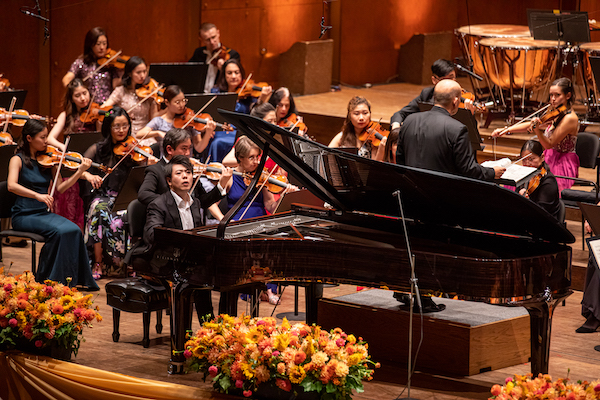Lang Lang shows sensitivity and depth in Philharmonic’s Beethoven gala

Composer anniversaries are a regular feature of programming in the classical music industry, but every few years we get one that really drives the repertoire for an entire season. Verdi and Wagner dominated opera stages in 2013 for their joint bicentenary; audiences should expect to hear an enormous amount of Beethoven this year as orchestras and concert halls mark 250 years since his birth.
Jubilee year or no, Beethoven’s Symphony No. 5 is perhaps the most enduring of all concert staples, so it was a natural choice to anchor the New York Philharmonic’s fall gala Monday night at David Geffen Hall. Of course, the Fifth is much more than a showpiece; Beethoven’s middle-period masterpiece is among the most astonishing, thrilling works in the standard repertoire and, in a great performance, can be a transcendent experience.
The rendition led by music director Jaap van Zweden in Monday’s gala had plenty of polish, but little excitement. In a sense, the outer movements mirrored each other, each tending in the wrong direction: the last movement was disorganized, the first too regimented. The torrid energy of the opening Allegro con brio comes in large part from the astonishing number of musical ideas that spill out from the primary motif, one after another. This requires a dynamic sense of forward motion to have its full effect, but the orchestra’s playing lacked focus, and dragged the pace backwards each time the tempo was reset.
In the finale, the pace simply never felt settled, fluctuating from phrase to phrase, and van Zweden never managed to get the dynamic levels quite right: the shining heroic, spirit of the main theme lacked the sorely needed contrast of the commotion underneath.
The inner movements were far more compelling: the Philharmonic brought rich, earthy warmth to the Andante, where van Zweden kept the orchestra in exquisite balance and led a purposeful progression through the structure of the movement, even at a deliberate pace. In the Scherzo, he drew brilliant contrasts between creeping quiet and the cold gleam of the orchestra in full voice.
The evening’s intrigue mostly came from the guest appearance of Lang Lang, in his first concert with the New York Philharmonic since tendinitis in his left arm forced him to cancel an entire year of performances starting in 2017. Still taking a careful approach to his recovery, the superstar who built a career on flashy performances of romantic warhorses is lately focusing on subtler, more cerebral repertoire. Beethoven’s Piano Concerto No. 2, the first piece on Monday’s program, can seem slight compared to its siblings, but Lang gave it a compelling argument, rich with feeling.
Characteristics of Lang’s distinctly unrestrained style certainly remained: an impulse to rush ahead whenever the orchestra fell silent, and some fussiness with the tempo in the Adagio.
Yet for the most part, this was a mature performance, achieving musical expression not just through dynamic contrast and metrical freedom, but also through subtler means such as variety of articulation. His phrases, often overly fussy, flowed clearly and naturally, and he approached the lively finale with grace and playfulness rather than trying to tear through it. Van Zweden drew lithe playing out of the Philharmonic, save in the Rondo, where the sound grew too heavy to capture the music’s bouncing spirit.
Time was a gala performance by Lang Lang would hardly have been newsworthy; his ability to electrify audiences made him one of the most regular stars for big-ticket concerts. Now thirty-seven, Lang may have put his young prodigy days behind him, but with poised playing like this, he can find a new, perhaps more lasting kind of success in the second act of his career.






